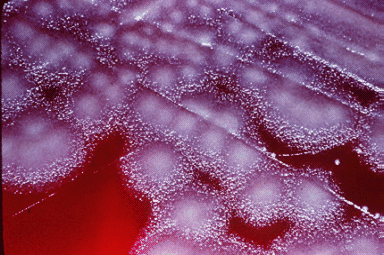BACILLUS
BACILLUS
 Bacillus represents a genus of Gram-positive bacteria which are ubiquitous in nature (soil, water, and
airborne dust). Some species are natural flora in the human intestines. When grown on blood agar,
Bacillus produces large, spreading, gray-white colonies with irregular margins. A unique characteristic
of this bacterium is its ability to produce endospores when environmental conditions are stressful. The only
other known spore-producing bacterium is Clostridium(anaerobic). Although most species of Bacillus are harmless
saprophytes, two species are considered medically significant: B.anthracis and B. cereus.
Bacillus represents a genus of Gram-positive bacteria which are ubiquitous in nature (soil, water, and
airborne dust). Some species are natural flora in the human intestines. When grown on blood agar,
Bacillus produces large, spreading, gray-white colonies with irregular margins. A unique characteristic
of this bacterium is its ability to produce endospores when environmental conditions are stressful. The only
other known spore-producing bacterium is Clostridium(anaerobic). Although most species of Bacillus are harmless
saprophytes, two species are considered medically significant: B.anthracis and B. cereus.
(under the microscope)

B. anthracis
B. anthracis is the bacterium which causes anthrax in cows, sheep, and sometimes humans. Anthrax is
transmitted to humans via direct contact with animal products or inhalation of endospores.
Under the microscope, B. anthracis cells appear to have square ends and seem to be attached by a joint
to other cells. The spores are best observed when the bacterium is cultured on artificial media.
Sources of infection are usually industrial or agricultural and the infection is classified as one of
three types:
- CUTANEOUS INFECTION (95% of human cases)
- INHALATION ANTHRAX (rare)
- GASTROINTESTINAL ANTHRAX (very rare!)
Anthrax can be treated with penicillin or tetracycline. A vaccine is available but is only used on
individuals at high risk of contraction.
LABORATORY INDICATIONS:
- Nonhemolytic (sheep blood agar)
- Non-motile
- Gel hydrolysis -
- Catalase +
B. cereus
Unlike B. anthracis, B.cereus is a motile bacterium which can cause toxin-mediated food
poisoning. It is known to inhabit many kinds of food including stew, cereal, and milk. Most recently,
however, it has been found in fried rice. The two toxins released by the bacterium
lead to vomiting and diarrhea, symptoms similar to those of Staphylococcus food poisoning.
Because toxin production usually takes place after the infected foods are cooked, proper cold storage
of food is recommended immediately after preparation.
LABORATORY INDICATIONS:
- Hemolytic (sheep blood agar)
- Motile
- Gel hydrolysis +
- Glucose, maltose, & salicin fermentative
- Catalase +




Copyright © 1995 University of Texas - Houston Medical School, DPALM MEDIC, All rights reserved.
 Bacillus represents a genus of Gram-positive bacteria which are ubiquitous in nature (soil, water, and
airborne dust). Some species are natural flora in the human intestines. When grown on blood agar,
Bacillus produces large, spreading, gray-white colonies with irregular margins. A unique characteristic
of this bacterium is its ability to produce endospores when environmental conditions are stressful. The only
other known spore-producing bacterium is Clostridium(anaerobic). Although most species of Bacillus are harmless
saprophytes, two species are considered medically significant: B.anthracis and B. cereus.
Bacillus represents a genus of Gram-positive bacteria which are ubiquitous in nature (soil, water, and
airborne dust). Some species are natural flora in the human intestines. When grown on blood agar,
Bacillus produces large, spreading, gray-white colonies with irregular margins. A unique characteristic
of this bacterium is its ability to produce endospores when environmental conditions are stressful. The only
other known spore-producing bacterium is Clostridium(anaerobic). Although most species of Bacillus are harmless
saprophytes, two species are considered medically significant: B.anthracis and B. cereus.




